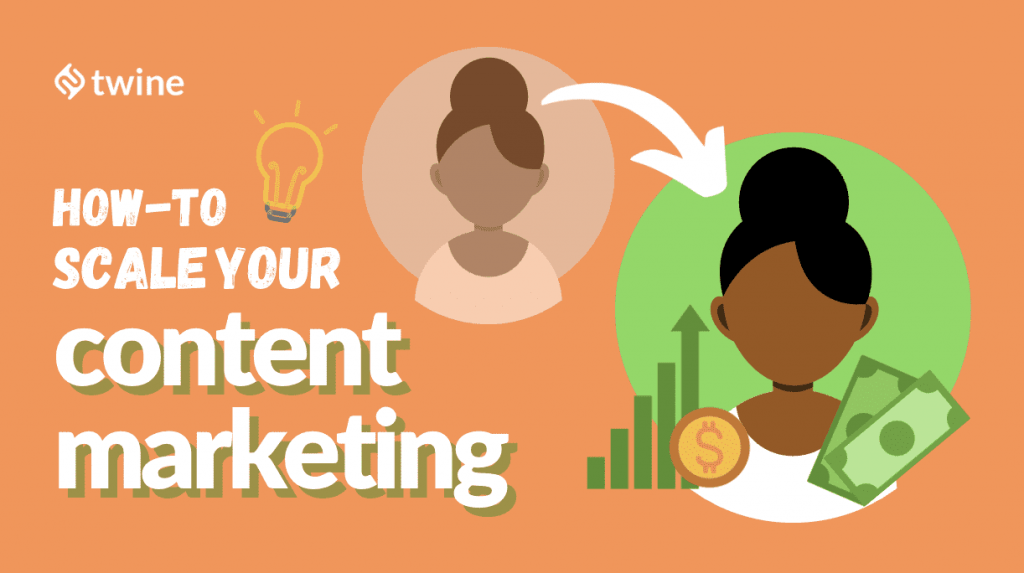
One of the primary aims of a business is to generate new leads. The fun doesn’t stop there – you also need to know how to turn that lead into a paying customer.
As search engines and social media update their algorithms, the challenge of acquiring leads gets more difficult. You need to constantly upgrade and update your content to stay relevant.
So, how do you do really turn a lead into a paying customer? Well, one of the most effective methods is by scaling up your content marketing.
Let’s dive in!
What Is Content Marketing?
Turn Leads into Paying Customers
SEO
Content Creation Process
Step 1: Discovery
Step 2: Engagement
Step 3: Call to Action
Step 4: Expand your Content Operations
Freelancer vs. Freelance Agency
Scaling Your Content Marketing
Key Takeaways
What Is Content Marketing?
Content marketing is pretty powerful.
When utilized correctly, it’s responsible for generating leads and converting a prospective client into a loyal, paying customer. It uses blog posts, infographics, social media content, case studies, website content, emails, podcasts, webinars, and many more types of content, to create an overarching presence for your business online.
In order to keep your target audience engaged, and browsing your content (daily), content marketing should be well-thought-out. The aim, generally, is to convince your audience to make a purchase, and further credit your brand.
It’s pretty vital you get your content marketing right too, as content is how you introduce your business to the world. When developed strategically, it can be a major source of sales – plus, who doesn’t want the opportunity to go viral?
Turn a Lead into a Paying Customer
Here’s some stats for you to really get to grips with content marketing: over 86% of businesses think good content marketing is one of the best sales strategies. That means, when you publish an article that is directed towards your clients, you tell them two things:
- You know what they’re looking for
- You know how to give them it.
As soon as you built this rapport with your clientele, you’re opening the door to another paying customer who trusts and believes in your brand.
SEO
You can’t talk about content marketing without discussing its hand-in-hand partner, SEO.
Using the right keywords, you can positively impact your domains’ search engine ranking, causing more traffic to go to your site. Although ranking for shorter keywords is better for visibility, it’s pretty difficult to get your foot in the door as a smaller company. Long-tail keywords are your best shot, as there will be less competition.
Your website content needs to be not only strong, but highly optimized for search engines. Think of your website as your digital business card – the only way to ensure success, is to infuse it with keywords, ensure a constant flow, and work on a wireframe that is user-friendly.
Your next step is to then create a show-stopping social media presence. When taken advantage of, social media can really influence your audience’s buying behavior and change that lead into a paying customer.
Content Creation Process

To better understand the content creation process, let’s visualize an example:
Say you have a new business that deals in car accessories. You make polished leather seats that are of great quality, and extremely long-lasting.
How are you going to ensure that people looking to buy leather car seats know about the quality of your products? How do you position your company in a way that reflects the excellent quality that you provide?
Here is a step-by-step guide for an effective content creation process – one that takes into account the stage where the customer is at:
Step 1: Discovery
First, the customer discovers your product. For this, you need to promote your product on social media, invest in a good website with SEO-optimized content, and channel a voice for your product.
If you were using Instagram, this would be your course of action:
- Upload good quality, high-definition images of all your products.
- Tell the customers that you source best-in-class raw materials to create gorgeous seat covers.
- Develop catchy captions and keep a tab on what’s trending (like Instagram reels or Carousel posts).
The discovery stage is the most important step, so you need to ensure that the content is optimized. Talk about the benefits of your products in a way that your audience wants to hear.
Scratch that, think like your audience.
Identify their pain points and direct your content towards that. Doing your research and launching your brand will cause your posts to reach more people, i.e. another chance to reach a new paying customer!
Step 2: Engagement
Okay, so now you have their attention. Your audience wants to know more about your product and is checking out your page. You also have a good follower base now, so what should be your next step?
Your aim is to stay relevant and give your followers something to look forward to. You have to take your content game to the next level and give them a reason to stay, or else you will bleed followers over time.
Update your feed regularly, whilst learning when the best time is for a new post. Create engagement through giveaways and live streams, and make your customers feel like a million bucks!
Step 3: Call to Action
A CTA (call to action) determines the final buying behavior.
With a definite call to action, you need to tell people how to place an order, why they should choose your services, and how buying your product will benefit them. You can even combine a good call to action with a free trial or a freemium to really get your customers to take action.
In our example, we can put emphasis on the aesthetic value that leather car seat covers will bring to the buyers’ cars. We’ll tell them how these covers can transform the way they drive and increase the value of their vehicle.
See what we did there? Using words like “transform” and “value”? If you’re in need of a few solid buzzwords, check out this article.
Step 4: Expand your Content Operations
At this point, you may be thinking “this is great and all, but it sounds time-consuming. How can I scale this process?”
The answer is: you hire a digital marketer who understands how the market works and is well-versed with content marketing techniques.
Whether it’s a freelance digital content marketer or an agency, they can uplift your brand voice, create powerful strategies and build campaigns that are specifically aimed at generating leads.
Also, the cherry on top is that you will be able to focus on other aspects of your business, win-win!
Freelancer vs. Freelance Agency

So, you want to outsource content marketing – we don’t blame you, it’s a pretty hectic process, best leaving it to the experts…
Although freelancing is our personal favorite (cough, cough), you have two choices; a freelance content marketing specialist OR an agency.
What’s the difference between the two? Let’s find out.
Freelance Content Marketer
Hiring a freelancer means hiring an individual on a contract or retainer basis to help you with content creation. They are the experts who draft good quality content and can provide you with a unique brand voice, and conduct in-depth research into the market.
According to a report by CMI, almost 70% of businesses now hire freelance content marketers to handle this side of operations. So, it sounds like you’re in good company!
However, given the wide range of services, is hiring an individual really the best option for you? Let’s find out by breaking down the pros and cons.
Pros:
- Budget: When you hire a freelancer, you hire an individual’s service as opposed to a team. This typically means less total cost.
- Greater flexibility: Freelancers have a knack for gelling beautifully with an existing team because they have experience of working with different sets of clients.
- No training required: When you hire an employee, you need to train them to understand the company dynamics, the brand, and its value proposition. With a freelancer, you’re hiring their services, which means they are already well trained.
- Short-term relationship: Hiring a freelancer gives you a chance to scale up or down, depending on your needs. You can always add more freelancers to the project at a later stage or find a different one if it isn’t working out.
Cons:
- Finding the right one is tough: Sourcing the right freelancer can be a problem if you don’t have any contacts. There are many freelancers out there, so finding one that’s the right fit can be an issue without a little help.
- Possible deadline issues: Depending on the detail of the project brief you created, sometimes there’ll be back-and-forth between you and the hired freelancer. This can lead to costly delays. Make sure to ask for regular follow ups, and ensure that you communicate reasonable deadlines before starting the project.
Content Marketing Agency
A content marketing agency is comprised of a team of digital marketers who develop marketing plans for your business. Each team member specializes in one niche, for instance: technical content writers, sales writers, SEO experts, and so on.
They provide a different experience to hiring a single freelancer as you’re paying for a wider skillset. Basically, more specialists, more ideas, and a better chance of you gaining a new paying customer… right?
Well, not always. Let’s look at the pros and cons of hiring a content marketing agency.
Pros:
- Accountability: With an agency, you don’t have to micro manage and follow up regularly. You are a business, a company, who has hired another company for their services.
- Bigger picture: If you’re looking for a lot of work to be done, in a large time-frame, an agency might be the right choice. Since you’re hiring a group, it’s likely that things will be done quicker due to more resource.
- Long-term: You won’t have to go through a tedious hiring process each time you need a new campaign – if you hire an agency, they’ll probably work on multiple projects with you.
Cons:
- More expensive: It goes without saying that an agency will be a more expensive choice, because you’re paying for the services of an entire team. They usually have an office space to work from, salaries to pay, holidays, sickness, etc.
- Round-the-houses: This is where more resource isn’t neccesarily a good thing. If there’s an issue, you may have to jump through several people in order to get to speak to the person in charge. With an individual freelancer, one issue could be handled in a single phone call…
Scaling Your Content Marketing

Before you hire anyone for your content marketing needs, you first need to establish a few baselines:
Define your goals
Defined goals help to get an understanding of the results you want from the campaign. Your goals may change from month to month, but by summarizing them, you’re giving yourself leverage to stand on.
This will also help you define the scope of work for the freelancer, as without your main goals, they really won’t know what they need to do…
Establish your budget
Come up with the numbers, and consider your budget before hiring anyone. A good rule of thumb is to aim lower than your budget, as it’s always safer to have backup funds, rather than splurging it all on one do-or-die project.
Negotiate with your freelancer how a payment style would look – they may require monthly, hourly, or milestone payments, this will all depend.
Make a choice
Freelancer or agency?
Well, if you’re in need of a low-budget, single goal-oriented project, that could be handled pretty easily by a freelancer. If you’re in the market for a more complex and high-budget project, then you might be better suited for an agency.
Take a look at what awesome, talented people are out there, and how they can benefit your business. Figure out what your business needs – maybe it’s totally opposite to what we say, and actually, one freelancer could take on the job of your entire campaign? Your budget, brand, and audience, will help influence your decision.
Prepare a style guide
Draft the do’s and don’t’s carefully, and prepare a guideline for your outsourced professional to follow.
This is critical for content development, as you can’t have a different tone of voice on your web pages than on your social media channels! There needs to be brand voice consistency and that can happen only when you have a style guide to refer to.
Use the right platforms
With over 430,000 freelancers, Twine is an excellent choice when you’re looking to outsource. Alternatively, if it’s agencies you’re after, Linkedin and Facebook are both pretty good for that. For establishing communication, email management software works great. Providing your content marketers with the right content marketing software tools is also pretty important when scaling your efforts. Setting yourself up on many platforms can ensure a great relationship between your audience and your brand.
Read testimonials
Post your vacancy and be detailed about the job description and budget, wait for the proposals and then choose from the available options. Read the testimonials, understand what kind of projects they have done in the past, and pay close attention to their writing style in their proposals.
You also have a choice of asking them to work on a paid project before fully committing to your campaign, so you can see if the freelancer or the agency is a good fit for your job.
Keep the terms clear
Be very clear in your direction. Lay out all the terms and conditions clearly before commencing work, and make sure that your outsourced professional understand your expectations, to avoid wasting time and resources.
Turn a Lead into a Paying Customer: Key Takeaways
We hope you enjoyed this article on turning a lead into a paying customer through your content marketing. We get it – if you’re not an expert, dabbling in content marketing can be pretty scary.
Maybe it’s a good idea to let the experts do the job? You might have the vision but you might not have the skills. Outsourcing the content would mean you get more time to do the job you signed up for.
Be it a freelancer or a freelance agency, both require a certain set of guidelines and clear briefs to work on. They both would work on a contract basis and are pretty easy to acquire. So, take a step back, analyze your goals, spell them out clearly and then make the decision!
Ready to get hired? At Twine, we have dozens of top-quality jobs being posted each and every day. From design to marketing, development to copywriting – there’s a job ready for your skills. Join the marketplace of creative talent here.








